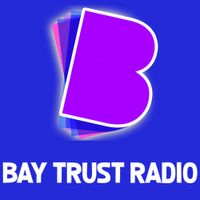Station History
The Story of Bay Trust Radio
From Humble Beginnings to Award-Winning Excellence
Bay Trust Radio has a rich and proud history of serving the community, evolving from a small hospital radio service to one of the most technologically advanced and respected voluntary radio stations in the North West. Here, we trace our journey from the very beginning through to the present day.
The Early Days: Kendal Hospital Radio (1976–1985)
December 1976
Kendal Hospital Radio was born from a community vision. A public meeting led to the formation of a committee, with Mr. Jim Bownass elected as the station’s first Chairman. Donations from patients, families, and supporters built the initial record collection, and financial support from the Hospital League of Friends made the purchase of equipment possible. Westmorland County Hospital provided accommodation, and the station officially took its first steps.
Sunday 6 February 1977
The first broadcast aired, hosted by Jim Bownass. This historic programme featured 60 music requests and an interview with Matron Daphne Cunningham. The show aired every Sunday at 8:15pm, quickly growing in popularity. A ward-based quiz—complete with a trophy donated by local business Philip Banks—was soon introduced, along with an Epilogue segment. Regular evening broadcasts followed, expanding to Saturday and Sunday.
1985
Kendal Hospital Radio became a registered charity and changed its name to Kendal Hospital’s Radio, reflecting its growing service to Kendal Green and Meathop Hospitals. With limited technology, a simple solution was adopted: record shows onto cassette tapes and deliver them for afternoon playback. By 1990, the station had amassed 20,000 music tracks—managed entirely with a card index system.
Growth and Modernisation (1991–2002)
1991
With the opening of Westmorland General Hospital, a new studio was established on Level 2, and operations were transferred from the old County Hospital.
1993
The music library expanded to over 30,000 tracks—surpassing many commercial stations—but aging equipment led to the station’s first major fundraising appeal. With generous support from the League of Friends and local donors, £10,000 was raised to purchase a mixing desk, turntables, and a cassette deck. A computer was also installed, allowing the record library to be fully digitised and indexed.
1990s Highlights
- Weekly live programming extended to seven days.
- The first outside broadcast was recorded at the Kendal Torchlight Procession.
- Innovations in archiving and indexing made the station more efficient.
Technological Transformation (2003–2012)
2003
In collaboration with Lakeland Radio, presenters explored new digital systems. Inspired, the station launched a £12,000 fundraising campaign to introduce computer-based playout. A grant from the National Lottery’s ‘Awards for All’ scheme and support from the League of Friends and WRVS made it possible.
2004
With the introduction of Myriad broadcasting software from P Squared, Bay Trust Radio became the first station in the North West to adopt Version 3. This modernisation elevated the station’s broadcasting capabilities beyond even some commercial stations. By the end of 2004, the station broadcast 24/7, featuring shows like Comedy Hour, In Concert, Golden Years, and the Sunday Service.
2007–2008
Bay Trust Radio was invited by Morecambe Bay NHS Trust to expand its broadcasts to the Royal Lancaster Infirmary. After months of planning, the station began serving both hospitals and officially rebranded as Bay Trust Radio.
Expansion and Recognition (2013–2019)
2013–2014
- Fibre optic broadband was introduced, enabling more frequent and reliable outside broadcasts.
- Grants from the Big Lottery Fund allowed the purchase of a Comrex Access system for live remote broadcasting.
- A modern new website launched with a 'listen again' feature.
- Myriad software was upgraded to include playout, scheduling, and news systems.
2016–2017
- State-of-the-art Axia iQ broadcast mixers were installed in both studios thanks to significant grants and donations.
- The station’s IT infrastructure was upgraded, and Studio 2 received a new air conditioning system.
- A refreshed logo and website design were introduced, along with new corporate wear sponsored by local businesses.
2018–2019
- In a significant development, Radio Victoria in Blackpool merged with Bay Trust Radio, forming one of the largest hospital radio services in the North West.
- The Kendal HQ server was upgraded to a Dell PowerEdge, and fibre broadband was installed at the Blackpool studio.
- June 2019: Bay Trust Radio received the prestigious Queen’s Award for Voluntary Service, the highest honour for UK volunteer groups.
Innovation During Adversity (2020–2021)
2020
Despite the challenges of the COVID-19 pandemic, Bay Trust Radio adapted swiftly. With grants and sheer determination, the station invested in the Myriad V5 system, enabling presenters to broadcast from home, maintaining service while protecting volunteers.
2021
- The station completed a full upgrade to Myriad 5.
- A major milestone: Bay Trust Radio began broadcasting on DAB+ across Morecambe Bay, reaching a wider audience through transmitters in Kendal, Windermere, Lancaster, and Morecambe.
- This expansion was made possible through NHS Together and extensive fundraising.
Continued Progress (2022–2025)
2022
Unfortunately, increasing costs meant the station had to end DAB+ broadcasts across Morecambe Bay in December.
2024
Bay Trust Radio took another leap forward with the upgrade to Myriad 6, offering even more powerful features and flexibility for presenters and listeners alike.
2025
- A completely redesigned, modern website launched, offering an improved experience for listeners and volunteers.
- In July, the station received a £1,725 grant from Cumbria Community Foundation (on behalf of Fibrus) to purchase five iPads and five wireless lavalier microphones—further enhancing its content production capabilities.
Looking Ahead
Bay Trust Radio continues to evolve while staying true to its founding mission: to provide comfort, entertainment, and companionship through high-quality broadcasting for hospital patients and the wider community. Powered by dedicated volunteers, supported by generous donors, and driven by innovation, our journey is far from over.

